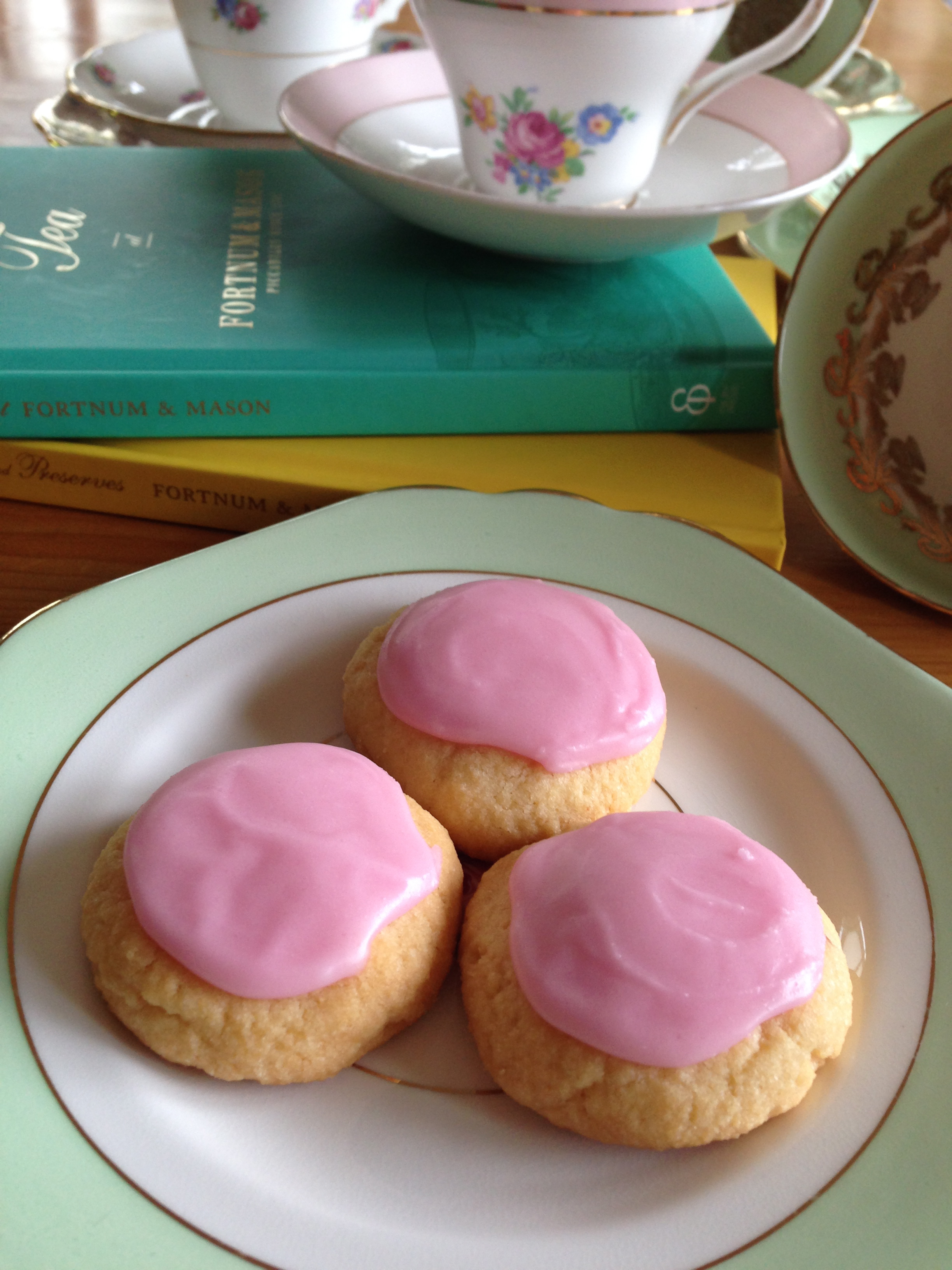I made these biscuits over Easter, hence the Easter egg and bunny shapes. But they would be lovely in any shape you would like! The book the recipe is from ‘Cookies’ by Peggy Porschen, has many wonderfully suggestions on what shapes to use and how to decorate the biscuits. Most of the biscuits are intricate and probably require a bit more skill and patience than I am will to provide, so I decided to use sprinkles to decorate the biscuits (and hide any evidence of poor piping skills!).
I came across Peggy Porschen, her cookies, shop and books, via Sweet Bake Shop, who now has her own store in Canada. Peggy is based in London, and when I was there just over a year ago, Mum and I walked all the way to Belgravia to go to her shop.
Peggy Porschen's Parlour - 116 Edbury St Belgravia, London.
I think we both agreed the walk was worth it. The shop was very cute, the cakes were lovely and the tea was good too. The areas of Chelsea and Belgravia are also quite nice to have walk around in as well. We ate cupcakes and sipped on tea, on some outside seats in the cold, but thoroughly enjoyed the experience!
I walked away with one of Peggy’s iced biscuits, a biscuit cutter and a copy of her ‘Cupcakes’ book. This ‘Cookies’ book came out later, as was given to me for my birthday last year. There are lots of hints and tips in the book about making the biscuits and icing them, and gives step by step instructions on how to do all of it. I used the vanilla biscuit recipe, and learnt that for such ‘sugar cookies’, you should chill the cut biscuits on their trays before baking for at least 30 minutes to ensure they don’t spread in the oven.
Tea and cake at Peggy Porschen, London.
I kept the icing for these biscuits white, as I wanted to decorate them with sprinkles. If you want to add colour, add it at the first stage of the icing, before you add more water to create soft peak icing for piping the edges or flooding icing to fill the biscuits. Add a small amount of colour to the mixture, and gently mix together with a palette knife. If you want multiple colours for the biscuits, you will have to divide the royal icing up at the first stage, and add the colours separately, and continue on with the following stages for each colour. Keep a bit of the white royal icing to the side (covered with a damp cloth), so you can adjust the shades of the icing colours.
I served these biscuits with simple flavoured milks, but now that the weather has got chillier, they would probably be best with a nice hot chocolate!
Ingredients for the Biscuits:
200 g unsalted butter, softened
200 g caster sugar
1 tbsp vanilla bean paste
pinch of salt
1 egg, lightly beaten
400 g plain flour, plus extra for dusting
Method:
Line 3 baking trays with baking paper.
Cream the butter, sugar, vanilla and salt in a large bowl until combined. Beat the egg in a glass or jug, and add slowly to the butter mixture. Mix until well incorporated. Sift in the flour and mix until just combined. Pull the dough together, and wrap in cling film and chill in the fridge for at least 30 minutes.
Place the dough on a lightly floured surface and knead briefly. Roll the dough out, until it’s about 4-5mm thick.
Cut out shapes with biscuit cutters, and place on the prepared trays. Once all the dough has been used, place the trays in the fridge so the dough can chill for a further 30 minutes before going into the oven.
Pre-heat oven to 200 degrees Celsius.
Bake the biscuits for 8-10 minutes, or until they are slightly golden around the edges and spring back when lightly touched. You may need to rotate the trays in the oven to evenly bake all the biscuits.
Place on a wire rack to cool.
Ingredients for the Icing:
500 g icing sugar, sifted
small squeeze of lemon juice
2 egg whites
sprinkles to decorate
Method:
In a large clean bowl of an electric mixed, place the icing sugar, lemon juice and three-quarters of the egg whites.
Mix on the lowest speed until the ingredients are well combined. If the mixture is too dry add more egg white. The mixture should be smooth but not wet. Scrape down the sides of the bowl after a couple of minutes, to ensure all the ingredients mix together properly. If the mixture is too runny, add a little more sifted icing sugar.
Continue to mix on the lowest speed for 4-5 minutes, ensuring the mixture doesn’t become too aerated. The mixture will be ready when stiff peaks form around the edges of the bowl, and has a smooth satiny texture.
To get the icing to a pipe-able consistency, run a palette knife under water and use to mix the icing. The icing should become glossier and the peaks should be softer.
Place some of the royal icing in a piping bag, with either a small nozzle or a small cut at the end. Cover the remaining royal icing with a damp cloth so it doesn’t dry out.
Draw an outline around the edge of each biscuit shape with the icing in the piping bag.
Now the remaining royal icing needs to be made into ‘flooding’ icing. Add a little water to the mixture, and mix with a spatula. The icing will flow, become shiny and flatten out within a few seconds after it has been mixed (i.e. it will no longer ‘hold its peak’ in any way). Tap the bowl on a bench or table to remove any air bubbles, then fill another piping bag with the icing. This piping bag should have a slightly bigger nozzle, or a slightly larger hole cut at the end.
If decorating with sprinkles, have a shallow bowl filled with the sprinkles ready, so you can dip the biscuits into it while the icing is still wet.
Flood each biscuit with the icing, keeping within the border you have already piped. Don’t over fill the bordered area of the biscuit with flooding icing or it may run over the piped outline. You may need to use a small palette knife or cocktail stick to push the icing in to small corners of the biscuit. Dip the biscuits (icing side down) in to the sprinkles.
Leave to dry for a few hours (or overnight), or until the icing has dried hard.
Original recipes from ‘Cookies’ by Peggy Porschen (Quadrille Publishing, 2014), pp.8 & 56-60.




























